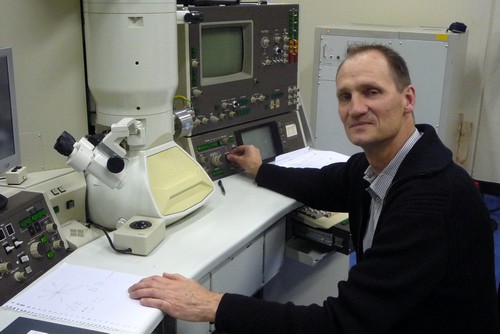Better steel thanks to nanotechnology
Nanotechnology looks at the very small. Although it might seem a world away from the chimneys of Tata Steel, Bart Kooi, leader of the research group Nanostructured Materials and Interfaces, is joining forces with this steel giant.
There is steel and steel. Alongside construction steel, there are specialized products such as steel for transformers for overhead power lines. This does not simply emerge from the oven. ‘The complex production processes make the steel for transformers one of the most expensive types of steel’, says Bart Kooi. This researcher at the University of Groningen Zernike Institute for Advanced Materials deals with materials science on the nanoscale. This is the key to good transformer steel.

‘The production process for this type of steel is a form of magic’, says Kooi. By this, he means that steel producers know how to make it, but do not understand why their method works. Each company keeps its own production method top secret, like the recipe for Coca Cola, to ensure that its competitors do not make off with it.
What Kooi can say is that it takes days to produce transformer steel. And that you need to add sulphides and nitrides, compounds of sulphur and nitrogen. ‘Transformer or electrical steel must have specific properties’, Kooi explains. ‘You need to be able to control the magnetism in the steel plates, and this must be quick and use as little energy possible.’
Transformers are needed to convert electricity that has been generated from a low to a high voltage – and back again. This is for transportation. The leakage current from overhead power lines is lower than in the standard 220 volts used by households, but there is still some leakage in the transformers. ‘It amounts to roughly seven percent of the energy generated, so a small reduction in this leakage could have a big impact.’
The magnetic properties of transformer steel must be as uniform as possible. Steel is made up of crystals that are normally arranged in a random order. This is unfavourable for the magnetic properties. ‘Steel producers know that rolling makes the texture strong, but the problem is that you end up with the wrong texture.’
This is where the magic comes in. Decades ago, it was discovered that by adding sulphide nanoparticles (and later nitride ones) you change the structure, giving you better transformer steel. The only trouble is that it is unclear how exactly this works. Kooi: ‘This was not particularly important for a long time, but the regulations on the efficiency of high-voltage transformers are always being tightened, a bit like with the environmental standards for cars.’ The path to improvement through trial and error is an uncertain one, so Tata is setting its sights on gaining a better understanding of the process. Together with FOM Foundation, it is therefore funding a PhD student in Kooi’s group via a research programme for High Tech Materials.
‘The sulphides and nitrides form tiny crystals in the steel of less than 100 nanometres in size’, says Kooi. ‘At a certain point in the process they dissolve, and at that precise moment the steel crystals suddenly begin to grow rapidly in the most favourable arrangement for transformer steel. Although they comprise less than a thousandth of the material, they suddenly begin to dominate massively.’
| Last modified: | 22 July 2019 1.13 p.m. |
More news
-
13 May 2024
‘The colourful cells of petals never get boring!’
Most people will enjoy colours in nature. However, the interest of evolutionary biologist Casper van der Kooi goes much further: he studies how flowers, birds, butterflies, and beetles get their colours. He also studies how these colours are used...
-
13 May 2024
Trapping molecules
In his laboratory, physicist Steven Hoekstra is building an experimental set-up made of two parts: one that produces barium fluoride molecules, and a second part that traps the molecules and brings them to an almost complete standstill so they can...
-
07 May 2024
Lecture with soon to be Honorary Doctor Gerrit Hiemstra on May 24
In celebration of his honorary doctorate, FSE has invited Hiemstra to give a lecture entitled ‘Science, let's talk about it’ on the morning of 24 May
